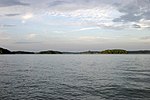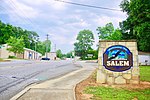Keowee

Keowee (Cherokee: ᎫᏩᎯᏱ, romanized: Guwahiyi) was a Cherokee town in the far northwest corner of present-day South Carolina. It was the principal town of what were called the seven Lower Towns, located along the Keowee River (Colonists referred to the lower reaches of the river as the Savannah in its lower reaches, with its mouth at the city they named Savannah). Keowee was situated on the Lower Cherokee Traders' Path, part of the Upper Road through the Piedmont. In 1752 the Cherokee established New Keowee Town nearby, off the traders' path but in a more defensible location. Both historic sites are within present-day Oconee County, South Carolina at the foot of the Blue Ridge Mountains. European Americans developed the town of Clemson, South Carolina, south of here after they began to populate the area. When the Keowee River was dammed in a mid-20th century hydropower project, both former Keowee sites were submerged in the early 1970s beneath the waters of Lake Keowee. Before that, archeological excavation was conducted by specialists from the University of South Carolina to establish history and recover thousands of artifacts. Human and animal remains were also discovered at the site.
Excerpt from the Wikipedia article Keowee (License: CC BY-SA 3.0, Authors, Images).Keowee
Crystal Cove Trail,
Geographical coordinates (GPS) Address Nearby Places Show on map
Geographical coordinates (GPS)
| Latitude | Longitude |
|---|---|
| N 34.854722222222 ° | E -82.915277777778 ° |
Address
Crystal Cove Trail
Crystal Cove Trail
29676
South Carolina, United States
Open on Google Maps






